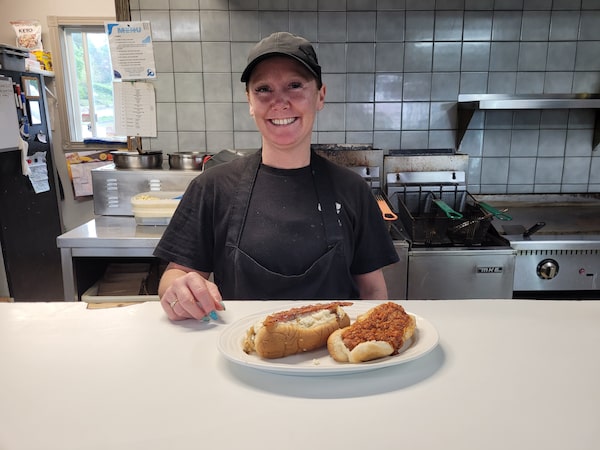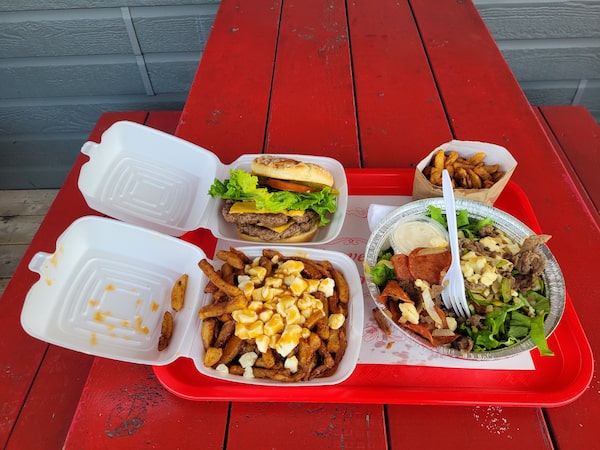
Kristel Daoust, owner of Casse-Croûte Le 200 in Brownsburg, Que., serves a hotdog Michigan and a guédille – a steamed hotdog bun with fried mushrooms, onion, cabbage, curd cheese and bacon.Sarah Efron/The Globe and Mail
In Quebec, the summer truly begins when the casse-croûtes open for the season.
These kitschy, old–style fast-food eateries are a well-loved part of Quebec’s culinary fabric. While casse-croûtes (literally, to break a bread crust, meaning to snack) are relatives of the roadside chip truck or the Maine lobster shack, they are a distinctly Québécois phenomenon, each with a similar menu inspired by 1950s and sixties Americana, peppered with the owner’s unique creations. They are important gathering spots for locals, and for outsiders like me, a strong symbol of the joys of exploring small-town Quebec in the province’s all-too-brief summertime.
On a recent Saturday afternoon at the 50-year old Casse-Croûte St-André in Saint-André-d’Argenteuil, Que., owner Francine Séguin hops behind the griddle after a wave of cars arrives. She pops on two handmade beef patties for the “Big burger St. André” – a hefty double burger with Cajun sauce. Then she loads the griddle with the fixings for her own culinary creation, the “submarine salad”: a bulky pile of beef, pepperoni and melted curd cheese served on a bed of greens. The deep fryer sizzles as Séguin makes fries for a classic poutine, complete with “brown sauce” and squeaky curds.
I first experienced this type of Quebec food when I came from Ontario to learn French in Trois-Pistoles the summer after I graduated from high school. Cantine D’Amours is a diner rather than a casse-croûte, but it serves the same things: hot chicken sandwiches, hotdogs, hamburgers and poutine loaded with various meaty, saucy toppings. I adored the friendly banter en français and the belly-warming comfort food that even then, several decades ago, was anachronistic.

Casse-Croûte Le 200 in Brownsburg, Que.Sarah Efron/The Globe and Mail
Emilie Villeneuve, author of the book Moutarde chou: Histoires, recettes et secrets des meilleurs casse-croûtes du Québec, also remembers the excitement each summer as a child when her family ditched their regular healthy meals to visit the local casse-croûte. The ones on the highway were special destinations they would visit while on vacation.
“The casse-croûte is born out of the same car and truck culture as all of North America,” she says. “You have to avoid the big highways and take the secondary roads – the old roads before the highways were built. That’s where you find them.”
On my first trip to Quebec, I realized the best way to improve my French was to nestle myself in Quebec’s rural areas and small towns, where I could avoid English. Several years later, I was back in casse-croûte country, volunteering on a farm in the Eastern Townships. Years later, on a bike trip along the St. Lawrence, I introduced my travel companion to the quirky goodness of the casse-croûte. These days, I still find myself back at these snack bars during family summer road trips with my Quebec-born partner and our son, who despite being from Ontario, adores the casse-croûtes of his ancestral homeland as well as the bars laitiers (ice cream bars) that often accompany them.
I had always assumed that the casse-croûtes had been built to showcase poutine, but it turns out, the dish is a more recent arrival. Poutine’s origins are murky, but it didn’t come on the scene until the 1970s, a decade or two after casse-croûtes began popping up across Quebec. The real focus of the menus, according to Villeneuve, is the fries themselves, and owners aren’t shy to boast that they have the very best.

The sizes of poutine are shown at Kristel Daoust's Casse-Croûte Le 200 in Brownsburg, Que.Sarah Efron/The Globe and Mail
At Miss Patate in Saint-Hermas (now part of Mirabel), Sarah Desrosiers spends four or five hours a day making fries when her seasonal casse-croûte is open. She starts three hours before opening, loading the potatoes into a noisy machine that removes their skin; then cuts and precooks them in oil for a dozen or so minutes. When customers arrive, the fries are cooked a second time. “That’s the secret of potatoes,” says Desrosiers, who has two young kids as well as a second job as a FedEx driver. “It’s a lot of work but it gives it a much better taste.”
Another core menu item is the steamé – a hot dog heated in a special steaming machine along with the bun, resulting in a moist, soft texture. It is often topped with coleslaw or spaghetti sauce, known as a hot dog Michigan. Menu items start to shift as you move eastward along the St. Lawrence River, says Villeneuve, with shrimp and lobster appearing. The taste of the poutine sauce also varies by region.
The guédille is another mysterious item for out-of-province visitors. It varies from place to place, but is generally a hot dog bun sans hot dog, stuffed with some type of mayonnaise-based filing. The guédille served up at Casse-Croûte Le 200 in Brownsburg, run by second-generation casse-croûte owner Kristel Daoust, is a steamed hot dog bun that buckles under the weight of fried mushrooms, onion, cabbage, curd cheese and bacon. These dishes will never be mistaken for fine dining, but they certainly are tasty.

The Big burger St. André, poutine, fries and a submarine salad at the Casse-Croûte St-André in Saint-André-d'Argenteuil, Que.Sarah Efron/The Globe and Mail
Some casse-croûte aficionados fear these far-from-modern eateries are at risk of disappearing, and Villeneuve says the numbers have dropped over the years. However, the owners I met on my recent trip all insisted that business was booming, with healthier additions to the menu, such as wraps and panini, gaining popularity. They all felt confident that their deep connections with their communities will keep locals coming back.
For travellers like me, casse-croûtes will continue to be an essential part of summertime in Quebec.
Where to find them
- Miss Patate: 4405 Chem. Clément-Pesant, Saint-Hermas (Mirabel), Que. Located inside a public park, this casse-croûte has easy access to a playground, skate park, splash pad and tennis court.
- Patate Ben-Venue: 1365 Rte 117, Mont-Tremblant, Que. In her book, casse-croûte chronicler Emilie Villeneuve includes the recipe for the Velveeta cheeseburger, a well-known dish from her local childhood snack bar.
- Chez Mag, La Fine Cantine: 2460 Chem. Royal, Sainte-Famille, Île d’Orléans, Que. Montreal-based restaurateur and wine importer Martin Juneau recommends this fancified casse-croûte for its “crazy good” lobster rolls and lobster poutine.
- Casse-Croûte St-André: 6 Rue Legault (near the junction of Highway 327 and 344), Saint-André-d’Argenteuil, Que.
- Casse-Croûte Le 200: 200 Rue Principale (Highway 327), Brownsburg, Que.
- Casse-Croûte 204: 715 Route De L’Eglise (Highway 204), Saint-Jean-Port-Joli, Que.